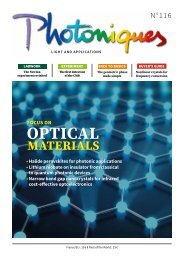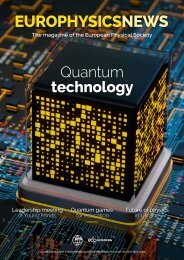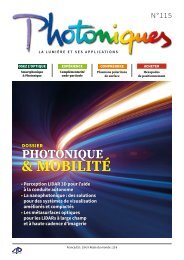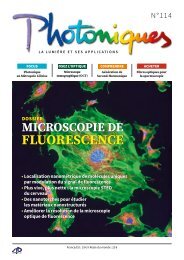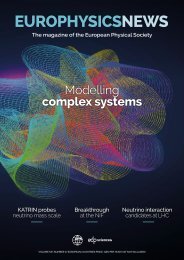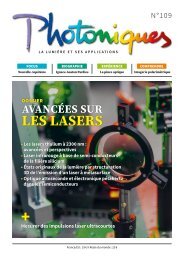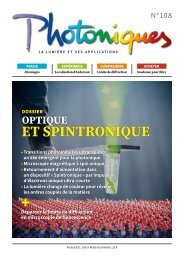EPN 53-3
Create successful ePaper yourself
Turn your PDF publications into a flip-book with our unique Google optimized e-Paper software.
TINY ROBOTS<br />
FEATURES<br />
up to a certain degree. We are particularly interested in<br />
robotic systems based on biomolecules, which have the<br />
ability to work in biological environments and interact<br />
with biological entities. Among the most prominent goals<br />
of this research direction is the realization of nanomedical<br />
robots that autonomously detect and cure diseases at<br />
the earliest stages, but also the generation of molecular<br />
assembly lines that enable the programmable production<br />
of chemical compounds is one of its grand visions.<br />
From biological inspiration to molecular<br />
and cell-scale robotics<br />
Biology has inspired the development of robotic systems at<br />
the macroscale in various ways. Their shapes and appearances<br />
are often derived from humans, dogs, or insects, etc.,<br />
and their movements and actions resemble those of their<br />
living counterparts. Roboticists are concerned with “motion<br />
planning”, “cognition”, etc. and therefore ask similar<br />
questions as neuroscientists. Another exciting example for<br />
biomimetics in this context is the field of swarm robotics,<br />
which is inspired by the observation of social interactions<br />
and dynamics among biological “agents”.<br />
At the cellular and molecular level, we can find inspiration<br />
for robots as well. Biological cells have sensors<br />
and actuators, they store and process information. They<br />
move, manufacture and interact with other cells. Other,<br />
specific examples are bacterial swimming and swarming,<br />
cell-shape changes, cell-cell communication, the immune<br />
system, muscle function, etc.<br />
In the end, biology is a very different kind of “technology”<br />
than electronics and mechatronics. Biological<br />
systems are self-organized chemical systems existing far<br />
from thermal equilibrium, and if we want to build bioinspired<br />
robots at this tiny scale, we will have to apply to<br />
other principles than those developed for “animal-scale”<br />
robotics. In the nano world, other physical laws are relevant<br />
than in our macroscopic world. For instance, gravity<br />
plays no role, but viscous friction is an important player.<br />
How should we think of or perform computation at this<br />
scale? Should we implement digital computation or develop<br />
molecular analog computers?<br />
DNA-based robots<br />
DNA-molecules turn out to be ideal to experimentally<br />
explore ideas for nanoscale robotic systems. DNA nanotechnology,<br />
especially the so-called “DNA origami”<br />
technique, makes it possible to assemble almost arbitrarily<br />
shaped molecular objects. Furthermore, various<br />
chemical and physical mechanisms have been used to<br />
switch these objects between distinct mechanical states.<br />
By doing so, linear or rotary molecular motors could be<br />
realized. DNA naturally lends itself for information storage<br />
and various computational schemes involving DNA<br />
have been developed. A wide range of DNA-based sensors<br />
– responding to nucleic acids, ions, small molecules<br />
or even light – are available. Thus, in principle, all of the<br />
aforementioned components of robotic systems can be<br />
realized with DNA alone. To name but a few, DNA robots<br />
have been created that act as smart drug delivery<br />
devices [2,3], DNA walkers have been shown that make<br />
decisions, sort, transport and assemble cargo [4-6], and<br />
DNA nanomechanical devices have been realized that<br />
can be actuated with magnetic or electric fields [1,7], or<br />
that themselves actuated soft robotic devices [8].<br />
While DNA-based robot prototypes are very promising,<br />
many challenges remain, and these will also have to<br />
be tackled by robots based on molecules other than DNA.<br />
First, the information processing capabilities of individual<br />
molecular structures are quite limited. Second, most<br />
realizations of DNA robots so far are slow and cannot<br />
quickly respond to external inputs. Thirdly, molecular<br />
robots are, of course, small. This makes it hard to integrate<br />
them into larger systems, let them move across larger<br />
length scales, and to operate many of them in parallel.<br />
Another challenge relates to the question how to best fuel<br />
the robots at this scale, whether they can be autonomous<br />
or must be externally controlled, etc.<br />
Biological molecular motors<br />
Proteins are another promising class of biomolecules<br />
which might be used to construct nanorobots. In biology,<br />
a plethora of molecular motors exist. For instance,<br />
processive motors such as kinesin walking along protein<br />
filaments or rotary motors that drive the flagella of bacteria.<br />
Protein-based motors on their own or in combination<br />
with DNA have already been utilized to create active<br />
materials [9,10] and “swarms” [11]. But autonomously<br />
moving particles or components alone will not make a<br />
robot. The challenge will be to integrate such active behavior<br />
with other functions, and it would be desirable to<br />
find ways to control and program active behavior. For<br />
example, after sensing the environment the output of a<br />
sensor module could be used to control a physicochemical<br />
parameter that is important for movement. Active<br />
particles that move in chemical gradients need to<br />
m FIG. 1:<br />
Robots and cells have<br />
similar functional<br />
modules and<br />
capabilities (the<br />
image only highlights<br />
a few examples). Can<br />
we create cell-scale<br />
robots that perform<br />
non-biological tasks<br />
or use biological cells<br />
themselves as robots?<br />
<strong>EPN</strong> <strong>53</strong>/3 25



